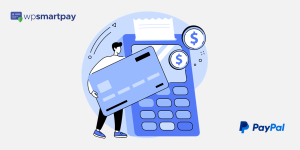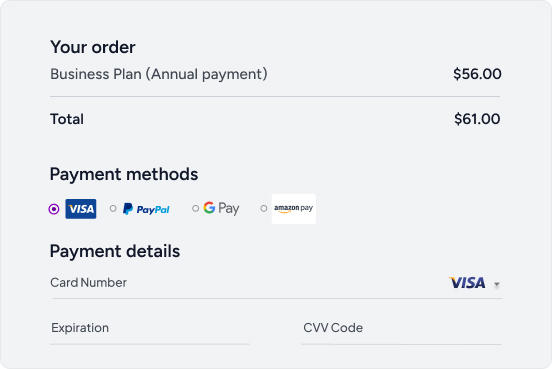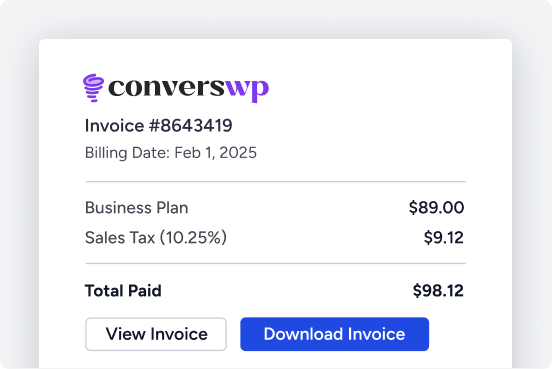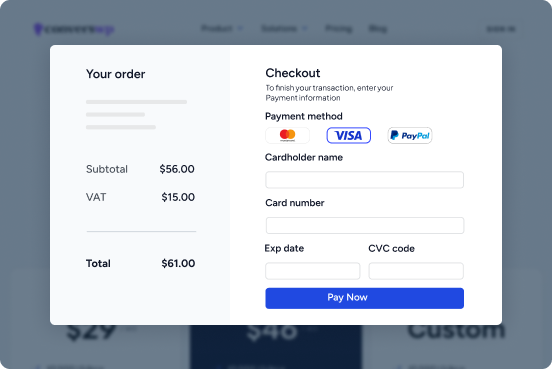 Key Takeaways
Key Takeaways
- The perfect fit: The best platform hinges on your industry, target audience, technical expertise, and specific feature needs
In the ever-competitive world of online payments, two solutions have emerged as industry leaders: Paddle and Stripe. While both platforms offer robust payment processing capabilities, their approach and feature sets cater to different business needs.
Paddle positions itself as a merchant of record, handling compliance and regulatory requirements, allowing businesses to focus on their core offerings. Stripe, on the other hand, provides more hands-on control and customization over the payment infrastructure.
This article delves into the nuances of Paddle vs Stripe, comparing their pricing models, features, integrations, and suitability for various business models. Whether you’re a startup or an established enterprise, this comprehensive analysis aims to help you make an informed decision that aligns with your goals and scaling aspirations.
What are Paddle and Stripe?
Paddle

Paddle is a robust payment platform that focuses exclusively on providing an end-to-end payments infrastructure tailored for SaaS, software subscription, and digital goods merchants. It excels at handling global sales, including subscriptions, one-time transactions, and complex tax compliance like VAT. Whether you’re a SaaS provider, software platform, or digital product vendor, Paddle offers powerful features and seamless scalability to support your growth.
Key Features
- 5% + 0.50¢ per sale flat rate pricing
- Built-in sales tax compliance for Europe, US, Canada, and Australia
- Fully customizable localized checkout options across 200+ countries and multiple currencies
- Automated VAT collection, filing and verification capabilities
- Focused subscription monetization tools like metered billing and instant license generation
- One-click instant payouts directly to all major banks globally
- Streamlined affiliate program and partner payout management
- Painless transparent platform pricing with sliding fee scale models
Of course, their comprehensive security standards make the list too – PCI DSS Level 1 compliance, bank-level encryption, extensive fraud protection and high service uptime guarantees.
Best Use Cases
- SaaS Companies: Manage global subscriptions and tax complexities effortlessly.
- Software Platforms: Offer secure and convenient purchasing options for digital products.
- Digital Product Vendors: Streamline sales processes and focus on creating amazing products.
Stripe
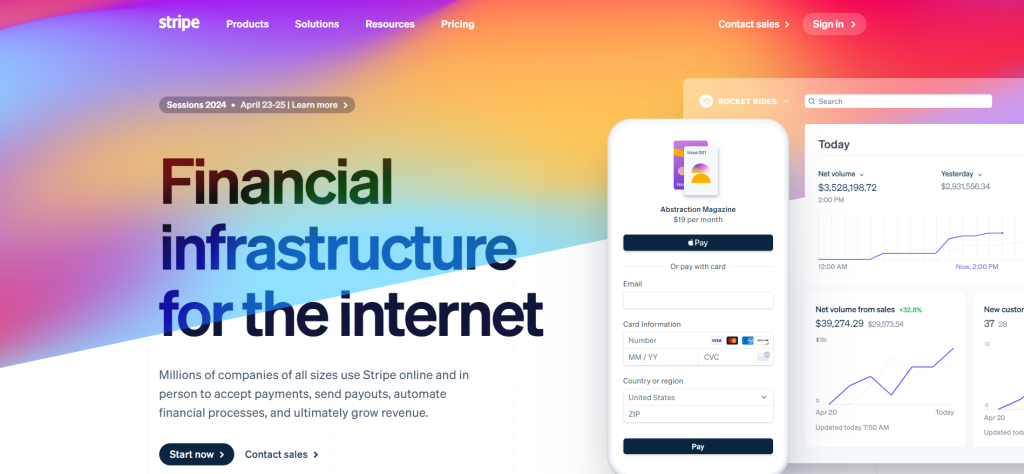
Stripe is a comprehensive payment processing platform that has revolutionized the way businesses handle online transactions. With a focus on simplicity and seamless integration, Stripe offers a robust set of tools and APIs that enable companies to accept and manage payments securely and efficiently. At its core, Stripe serves as a payment gateway, facilitating the transfer of funds between customers and businesses while ensuring compliance with industry standards and regulations.
Beyond its core payment processing capabilities, Stripe has evolved into a powerful ecosystem, offering a suite of interconnected products tailored to meet the diverse needs of modern businesses. From checkout experiences to invoicing, subscription management, and fraud prevention, Stripe’s comprehensive solutions help streamline every aspect of the payment lifecycle.
Key Features
- Customizable pricing models, including flat-rate and percentage-based options (e.g., 2.9% + $0.30 per successful card charge, 5.99% + $0.30 for Klarna)
- Built-in tax calculation and reporting for various regions, including the US, Canada, and Europe
- Localized checkout experiences with support for multiple languages and currencies
- Automated tax calculation, collection, and remittance capabilities for various tax jurisdictions
- Robust subscription management tools, including metered billing, proration, and trial period support
- Fast payouts to bank accounts in over 30 currencies and various payout schedules (e.g., daily, weekly)
- Partner and affiliate program management tools, including customizable payouts and reporting
- Transparent pricing structure with volume-based discounts for larger businesses
Stripe offers robust security features to protect sensitive payment data and mitigate fraud risks, including PCI-DSS compliance, tokenization of payment details, advanced fraud detection algorithms, and secure customer authentication methods like 3D Secure.
Best Use Cases
- E-commerce businesses: Streamlined checkout, multiple payment options, and robust fraud prevention for online retailers.
- Subscription-based models (SaaS, media, digital content): Comprehensive subscription management tools for recurring billing and revenue models.
- On-demand services and marketplaces: Secure and seamless payment processing for on-demand platforms like ride-sharing and food delivery.
Paddle Vs Stripe: Features and Functionality
Both Paddle and Stripe are heavyweights in the online payment processing arena, catering specifically to software businesses, digital goods sellers, eCommerce and SaaS companies. They boast comprehensive feature sets to streamline global sales, manage subscriptions, and boost revenue. But how do they compare head-to-head? Let’s take a closer look at their key functionalities:
| Features | Paddle | Stripe |
|---|---|---|
| Target Audience | Ambitious online businesses, SaaS providers, software platforms, digital product vendors, WordPress-based eCommerce and digital download businesses (Paddle for EDD and Paddle for WooCommerce) | Global businesses across industries, e-commerce, on-demand services, subscription models, digital products |
| Global Reach | 200+ currencies, localized checkout experiences | 135+ currencies, localized experiences |
| Subscriptions | Powerful management tools, flexible pricing plans, churn reduction strategies | Robust subscription management, metered billing, trial periods |
| Tax Compliance | Handles VAT and other regional taxes | Tax calculation and reporting for various regions |
| Security | Robust PCI-DSS compliance, advanced fraud prevention, data encryption | PCI-DSS compliance, tokenization of payment details, advanced fraud detection algorithms, and secure customer authentication methods like 3D Secure. |
| Scalability | Handles high transaction volumes, scales with your business | Handles high transaction volumes, scales with your business |
| Ease of Use | User-friendly interface, but requires some technical knowledge | Developer-friendly APIs, requires technical integration |
| Built-in Marketing Tools | Limited integrations with marketing platforms | Integrations with marketing/analytics tools |
| Mobile-First | Mobile-optimized checkout | Mobile-optimized checkout |
| Pricing | Transaction fees + potential volume discounts | Customizable pricing models, percentage + fixed fee |
| Hidden Fees | None | None |
| Integrations | More integrations with eCommerce platforms and tools | Extensive integration options across platforms/languages |
| Reporting and Analytics | Robust reporting and analytics capabilities powered by ProfitWell Metrics | Detailed reporting and analytics for transaction data |
| Customer Support | Email support Live chat support Comprehensive knowledge base Community forums Phone support (for higher pricing tiers) | Email support Live chat support API reference material Stack Overflow community Premium phone and Slack support (for Stripe’s top pricing tiers like Enterprise) |
Note: If you’re using Easy Digital Downloads or WooCommerce, consider Paddle for EDD and Paddle for WooCommerce. They offer native integrations and optimized features for those platforms, streamlining setup and maximizing your WordPress experience.
Paddle for EDD
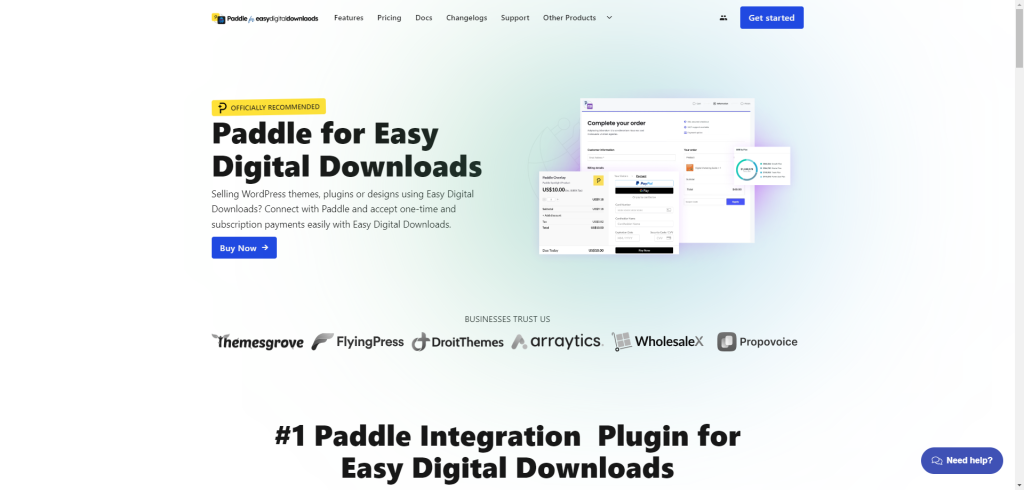
- Targets users of the Easy Digital Downloads (EDD) plugin, a popular platform for selling digital products on WordPress.
- Seamlessly integrates Paddle’s powerful capabilities like global payments, subscriptions, tax compliance, and advanced fraud protection within the EDD interface.
- Provides additional features like automatic license generation, discount management, and one-click payouts, all geared towards simplifying and scaling digital product sales through EDD.
Paddle for WooCommerce
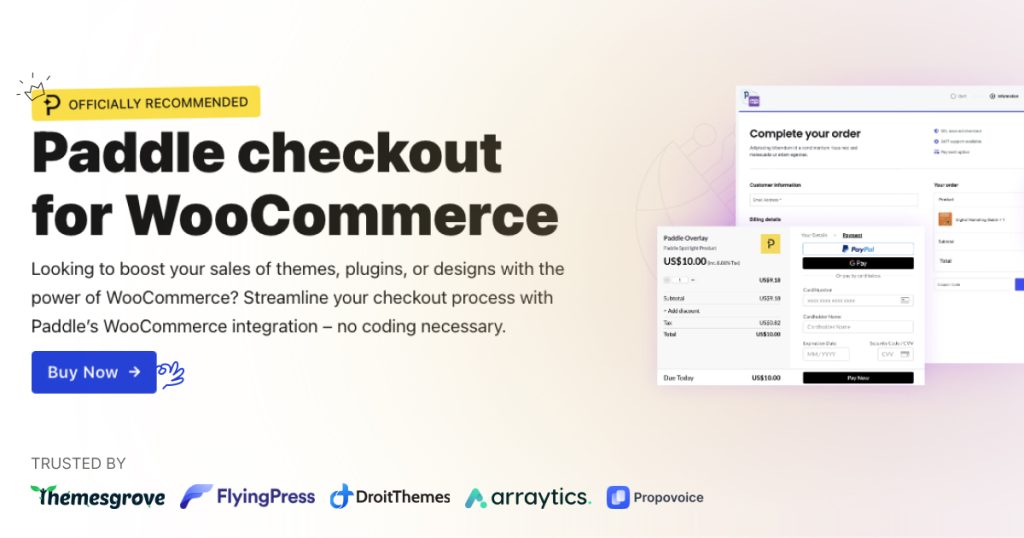
- Caters to users of the WooCommerce plugin, a widely used eCommerce platform for WordPress.
- Connects WooCommerce websites with Paddle, enabling secure and smooth processing of one-time and recurring payments for physical and digital goods.
- Offers features like convenient checkout experiences, international tax handling, and robust subscription management tools specifically designed for WooCommerce environments.
Essentially, both Paddle for EDD and Paddle for WooCommerce leverage the benefits of the Paddle payment gateway but make them readily accessible and enhance their functionality within the familiar interfaces of EDD and WooCommerce, respectively. This makes them ideal choices for WordPress users already comfortable with these plugins and wanting powerful payment solutions without leaving their preferred platform.
Supported Payment Methods
Paddle: Think global citizen here. With over 200 currencies, popular e-wallets like Apple Pay and Alipay, and adaptable local payment methods like SEPA Direct Debit, Paddle embraces your customers’ preferred payment options anywhere in the world. This inclusivity fosters trust and smoothens cross-border transactions, especially in emerging markets.
Stripe: Mirroring Paddle’s reach, Stripe offers a comprehensive suite of payment methods to meet your customers’ needs worldwide. This includes popular credit and debit cards, e-wallets like Apple Pay and Alipay (with limitations), alternative payment methods like ACH Direct Debit and SEPA Direct Debit depending on the region, Buy Now, Pay Later options in select areas, local real-time favorites, and even limited support for cash-based vouchers in specific regions. Just like Paddle, Stripe prioritizes a global approach with a vast selection of options to build trust and conversions around the world.
Global Reach
Paddle: Picture borderless commerce at its finest. Paddle enables sales in 200+ countries, complete with localized checkout experiences tailored to language, currency, and cultural preferences. Paddle simplifies international expansion, new product launches and more. This creates a seamless and familiar experience for customers worldwide, boosting conversion rates and brand loyalty.
Stripe: Stripe isn’t afraid of borders either! They boast global reach with support for accepting payments in over 195 countries. Similar to Paddle, Stripe tailors the checkout experience to local languages and currencies, fostering a familiar and frictionless buying experience for your international customers. This focus on global usability helps drive conversions and brand loyalty wherever you sell.
Currency Conversion
Paddle: Say goodbye to manual calculations and potential pricing errors. Paddle handles automatic currency conversion at competitive rates, ensuring a hassle-free experience for both you and your customers. This removes a technical hurdle and fosters trust in your global pricing strategy.
Stripe: Streamline your finances with automatic currency conversion. Just like Paddle, Stripe handles the conversion process for you, using competitive exchange rates to ensure accurate pricing for your customers globally. This eliminates the need for manual calculations and potential errors, simplifying your operations and building trust in your international pricing strategy.
Fraud Prevention
Paddle: Paddle leverages advanced fraud detection algorithms and machine learning techniques to identify and mitigate potential risks. Their system analyzes various data points, including IP addresses, purchasing patterns, and device information, to flag suspicious activities. Additionally, Paddle offers customizable fraud filters, allowing merchants to define their own rules and thresholds based on their specific risk profiles.
Stripe: Stripe’s fraud prevention arsenal is built on a multi-layered approach. Their Radar tool utilizes machine learning models and a vast data network to assess the risk of each transaction in real-time. Stripe also provides customizable rules and blocklists, enabling merchants to implement their own fraud prevention strategies. Furthermore, Stripe offers advanced features like 3D Secure authentication, address verification, and card verification value checks to enhance security.
Chargeback Management
Paddle: Paddle takes a proactive approach to chargeback management. Their system automatically responds to chargeback notifications, gathering relevant transaction data and evidence to support merchants’ cases. Paddle also provides detailed chargeback reporting, enabling businesses to identify patterns and potential areas of improvement in their processes.
While Paddle handles the initial chargeback response, merchants are responsible for providing additional documentation or information if needed during the dispute process. Paddle’s knowledge base offers guidance on best practices for chargeback prevention and management.
Stripe: Stripe’s chargeback management capabilities are tailored to meet the diverse needs of businesses. Their Radar tool helps identify high-risk transactions, allowing merchants to implement appropriate measures to mitigate chargeback risks.
When a chargeback occurs, Stripe provides merchants with comprehensive chargeback reports and evidence packages to support their dispute cases. Additionally, Stripe offers customizable chargeback response options, enabling merchants to automate or manually respond to chargeback notifications.
For businesses with higher chargeback volumes or specific requirements, Stripe offers advanced chargeback protection services through partnerships with third-party providers. These services can include detailed chargeback reason code analysis, representation during dispute processes, and tailored strategies for chargeback prevention and recovery..
Reporting and Analytics
Paddle: Dive deep into data-driven insights with rich analytics powered by ProfitWell Metrics. This tailor-made solution for subscription businesses allows you to benchmark key SaaS metrics against industry data, utilize predictive modeling to identify at-risk accounts, and access API pipelines for data-driven decision-making. This eliminates the need for separate analytics tools and empowers you to optimize your pricing, churn reduction strategies, and expansion plans.
Stripe: Stripe offers in-depth payment analytics with customizable reports and a flexible dashboard. Analyze transactions, revenue, methods, currencies, and customer behavior. Make data-driven decisions by identifying trends and optimizing your payment strategy. It also integrates with popular BI tools for seamless data analysis.
Integrations
Paddle: Streamline your workflow with a vast library of integrations covering popular eCommerce platforms, CRMs, marketing tools, and more. This seamless ecosystem allows for automated tasks and data exchange, boosting efficiency and productivity. Additionally, dedicated solutions like Paddle for EDD and Paddle for WooCommerce cater specifically to WordPress users.
Stripe: Stripe boasts a powerful and versatile integration ecosystem, catering to diverse businesses. It seamlessly connects with popular e-commerce platforms (Shopify, WooCommerce, Magento), subscription management tools (Chargebee, Recurly, Zuora), marketing and analytics platforms (Google Analytics, Segment, Mixpanel), and empowers developers with extensive APIs and SDKs for custom integrations. This flexibility ensures Stripe integrates smoothly into your existing tech stack, maximizing its functionality for your business.
WPSmartPay now integrate @PaddleHQ billing with @WooCommerce 🎉
— Parvez Akther — oss/acc (@parvezvai) March 11, 2024
Read more here https://t.co/4XoHIkAQFp pic.twitter.com/dP0NWqc0a0
Distinct Features of Paddle and Stripe
Paddle
Flexible Monetization Tools: Paddle makes it easy for SaaS companies to experiment with pricing models and optimize monetization strategies over time. Its metered billing and usage-based pricing features support innovative models like trials, free plans, credits, and more. This flexibility allows businesses to fine-tune their offerings to maximize revenue.
Comprehensive Tax Management: For companies selling software globally, tax compliance is a major headache. Paddle provides complete VAT, GST and sales tax solutions out-of-the-box for Europe, North America, Australia and beyond. This saves teams the pain of managing different jurisdictional rules and filings.
Instant Global Payouts: Paddle offers one-click payouts directly to bank accounts across the world, with daily transaction reconciliation. This level of speed and transparency for global payments is extremely rare in the payments industry. Sellers can access their earnings instantly no matter where they are located.
Stripe
Focus on Developer Experience: Stripe prioritizes developer friendliness with a robust suite of APIs, comprehensive documentation, and a variety of pre-built integrations. This allows developers to quickly and easily implement Stripe into their applications, reducing development time and effort. Stripe also boasts a vibrant developer community for knowledge sharing and troubleshooting.
Marketplace Capabilities: Stripe offers robust marketplace functionality, enabling businesses to facilitate transactions between buyers and sellers on their platforms. This includes features like payout splitting, managed accounts, and fraud protection specifically designed for marketplace settings. Stripe empowers businesses to build and scale complex marketplaces seamlessly.
Subscription Management: While Paddle excels in metered billing, Stripe provides a well-rounded subscription management solution. It allows businesses to create different subscription plans, manage customer subscriptions, handle dunning and retries for failed payments, and offer prorated billing. Stripe caters to a broader range of subscription needs.
Pricing and Fees
When choosing a payment services provider, one of the most crucial considerations for any business is costs. Between payment processing rates, platform fees, and additional hidden costs, expenses can quickly pile up. In this section, we examine and compare the pricing models of Paddle and Stripe.
Paddle Pricing
Paddle offers an all-inclusive, transparent pricing model covering payments, subscription billing, tax compliance, fraud protection, and more under one platform. There are no hidden fees or additional costs.
Their pay-as-you-go pricing starts at 5% + 0.50¢ per transaction, delivering essentials like global payments, built-in tax compliance, chargeback protection, and fraud screening.
Paddle provides customized pricing for rapidly scaling or large enterprises to unlock additional premium capabilities like migration services, implementation support, and dedicated success management.
It’s important to note that there are services, Paddle for EDD and Paddle for WooCommerce, that offer customized pricing plans suited for the specific needs of WordPress sites, taking into account transaction volume, subscriptions, and other factors. These services both start at $89/year. For more detailed information visit this link.
Stripe Pricing
Stripe offers a transparent per-transaction pricing structure, unlike Paddle’s all-inclusive model.
You’ll pay 2.9% + $0.30 per successful transaction for most credit cards and wallets, with potential additional fees for international cards (1%), currency conversion (1%), ACH Direct Debit in the US (0.8% up to $5), and other payment methods (variable fees).
While Stripe avoids monthly platform fees, ideal for fluctuating sales, consider potential extra charges for international transactions, conversions, and specific payment methods for a complete cost comparison. High-volume businesses may qualify for custom pricing with lower fees, but you’ll need to contact Stripe directly for a quote.
Ease of Use and Support
When evaluating a billing and payment platform, ensuring a positive user experience through intuitive interfaces and helpful resources is key. Both Paddle and Stripe have invested in creating intuitive interfaces and providing robust support channels to ensure a seamless experience for their users.
For Paddle, easy-to-configure billing models, actionable customer insights, tailored gaming monetization features, and localized checkout experiences are top strengths that underpin their commitment to user-focused design principles. Hands-on support and 95%+ customer satisfaction gives Paddle users peace of mind during launch and expansion stages.
Paddle offers a comprehensive knowledge base, community forums, and email and live chat support channels. These resources provide merchants with access to detailed documentation, troubleshooting guides, and direct support from Paddle’s experienced team.
Testimonials from CEOs attribute considerable operational efficiencies and cost savings to Paddle’s ability to minimize billing administration overheads. Access to ongoing revenue metric benchmarking against wider industry subscription data also provides data-driven assistance.
While Stripe’s platform is renowned for its extensive functionality and flexibility, its ease of use often caters more to developers and technical teams. Integrating Stripe into existing systems and workflows may require a deeper understanding of programming languages and APIs.
However, Stripe’s comprehensive documentation, API reference materials, and developer resources make the learning curve more manageable for technically proficient users. Additionally, Stripe offers extensive support channels, including email and live chat support, Stack Overflow community forums, and GitHub repositories for issue tracking.
For businesses with dedicated development resources, Stripe’s developer-friendly approach can be an advantage, enabling them to fully leverage the platform’s customization capabilities. However, for businesses without technical expertise, the integration process may present a steeper learning curve.
Support-wise, both Paddle and Stripe offer robust resources and channels to assist their users. Stripe’s support options are particularly extensive, including premium phone and Slack support for its top-tier enterprise customers.
While Paddle’s user interface may be more intuitive for non-technical users, Stripe’s developer-centric approach can be advantageous for businesses with technical teams seeking granular control and customization capabilities.
Security and Compliance
With payment platforms processing valuable customer data, having rigorous security protocols and compliance with privacy regulations is non-negotiable. We examine how Paddle and Stripe stack up on key parameters of trust and transparency for customers.
Paddle offers best-in-class security reinforced through adhering to SOC 2, GDPR standards, undergoing regular pentests/audits, and being PCI DSS Level 1 certified – the most stringent level. Their security portal offers in-depth documentation around policies, procedures, recovery metrics, access control, and development practices.
With AWS cloud hosting, role-based access controls, MFA authentication, and advanced threat monitoring via SIEM systems, they check all the boxes for enterprise-grade security. A dedicated security team and proactive vulnerability disclosure program further underpin their mature posture.
Matching Paddle’s security focus, Stripe prioritizes data protection and regulatory compliance. They hold the highest PCI DSS Level 1 certification and adhere to industry standards like SOC 2 and GDPR.
Customer information is secured through Amazon Web Services’ robust infrastructure featuring access controls, multi-factor authentication, and constant threat monitoring. A dedicated security team proactively identifies vulnerabilities, encrypts data in transit and at rest, and maintains a transparent disclosure program.
Like Paddle, Stripe offers a comprehensive, industry-approved security approach for peace of mind when processing payments.
Use Cases and Recommendations
With a detailed analysis of core capabilities, security, pricing, and ease of use behind us – we wrap up with recommendations on ideal customer profiles who stand to benefit the most from Paddle and Stripe respective offerings.
Businesses Who Are Best Suited for Paddle:
Given its robust feature set and premium pricing, Paddle shines best for well-established businesses with complex global operations including:
- Mid-market to enterprise SaaS companies earning over $10M+ in revenue
- Gaming studios with 50,000+ users and multi-SKU monetization
- Digital publishers generating high 6-7 figure subscription income
- WordPress-based eCommerce and digital download businesses. Paddle for EDD and Paddle for WooCommerce are tailor-made for these platforms, offering powerful features and seamless integration to help your WordPress site thrive
Specifically, the ability to customize sophisticated subscription billing constructs, executive sales tax calculations across 200+ countries, and tap detailed cross-border consumer spending data make Paddle worthwhile for expanding companies.
Those needing niche accommodations like metered pricing models for API usage, certificate generation for software licenses, or risk management around fluctuating cross-border tax jurisdictions will find that they have unmatched capabilities with Paddle.
Businesses Who Are Best Suited for Stripe:
Stripe’s versatility and scalability make it an attractive choice for businesses across a wide range of industries and sizes, including:
- Startups managing fluctuating sales and streamlining operations.
- Businesses that cater to a global customer base.
- Businesses with various subscription models.
- Stripe’s developer-friendly API, documentation, and vibrant community empower businesses with custom development needs to quickly integrate Stripe into their applications.
Stripe’s comprehensive feature set, including advanced fraud prevention, detailed reporting and analytics, and support for various payment methods and currencies, make it a versatile choice for businesses across diverse industries and stages of growth.
Additionally, Stripe’s ecosystem of integrations with popular e-commerce platforms, marketing tools, and business intelligence solutions allows businesses to seamlessly incorporate payment processing into their existing technology stacks.
While Paddle may be more tailored towards software vendors and digital publishers, Stripe’s flexibility and robust feature set make it a compelling choice for businesses seeking a scalable and customizable payment solution that can adapt to their evolving needs.
Paddle vs Stripe: Choosing Your Payment Powerhouse
This deep dive into Paddle and Stripe has unpacked their strengths across pricing, features, security, and ideal use cases. Here’s the key takeaway:
- Paddle empowers established businesses: Paddle excels with its all-inclusive pricing, robust tax solutions, and advanced monetization tools, making it ideal for established SaaS companies and digital goods platforms seeking a scalable payment infrastructure.
- Stripe offers versatility for all: Stripe’s flexible and developer-friendly approach caters to a broader spectrum of businesses, from e-commerce to on-demand services and subscriptions. Its vast integrations, customization options, and comprehensive features make it a strong choice for businesses with diverse and evolving needs.
The perfect fit:
The best platform hinges on your industry, target audience, technical expertise, and specific feature needs. Both prioritize security and fraud prevention for peace of mind.
As the payment landscape evolves, Paddle and Stripe will keep innovating. By carefully evaluating their unique strengths and aligning them with your specific business goals, you can choose the payment processor that fuels your growth and success for years to come.


